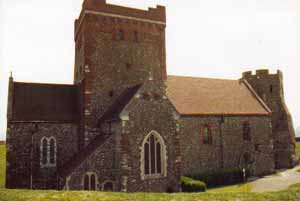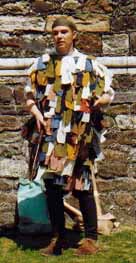Dover Castle
Dover Castle, one of the most extensive castle complexes around England, is still used today for military, religious and government purposes.
Dover is on the south eastern corner of England. It is built on cliffs. Did you know that the rock foundation of England is basically chalk? It is just like the chalk that they use on blackboards. We picked up a piece and wrote on the sidewalk, it works like the chalk Iíve used before. A million or so years ago, the coast of England was farther south, but the constant attack by the waves in the channel have made awesome cliffs out of chalk. They are huge and white. A site to see. We spent the day climbing hills and stairs, you can not get from one place to another without climbing something.
 The Church
The Church
Calais, France is just across the channel. We were unable to see the coast from Dover the day we visited, although it is possible to see on a clear day. The ferries to France leave from the Port of Dover, constantly moving in and out of the harbour. We watched as a hovercraft took off. The hovercraft is a vessel that moves across the water or land on air. The craft hovers above the surface of the land or sea.
The chalk foundation on which Dover is built is so easy to tunnel through that over the ages, residents have made tunnels that have been used for many purposes. There are some from medieval times, Napoleonic times, and some are much more recent. This is an extremely strategic site, and has been the site of a military fortress for 2500 years. We listened to a man in costume speak on the history of Dover. He told us that we were standing on a site that was originally an iron age fort, then through the later history. The church that stands near that spot has been serving military members for more than 1400 years (although the building was replaced over the centuries).
 The Military
The Military
The tunnels have been used in the recent past, and some are still considered secret. They arenít very secret, but they are not open to the public at this time. The bottom level of tunnels was built in response to the threat of nuclear war. It is a fall out shelter that would have become the regional seat of government in the event of an emergency. There is also a place for the royals to stay when visiting the area. BBC-1 broadcasts out of some of the tunnels (as the guide told us, ďIf you survive the blast, then you can still watch Eastenders!) The Dunkirk Evacuation during WWII was planned and executed from these tunnels. There was a field hospital inside, which the locals didnít even know existed. The Dunkirk evacuation was so successful that they far exceeded their expectation of saving 45,000 people. They actually saved 300,000+! D-day was also planned from this site. We took the hour long tour through the tunnels, which included a couple of movies and some of the tunnels. The guide told us we walked 1 ľ miles and barely saw 10% of the tunnels. They had special effects, such as lights blinking and the sounds of bombs exploding. You could even smell the food in the chow hall and the smells in the operating rooms.
Outside the keep is the curtain wall with outer buildings. Most of them were from a later date, built as barracks. Outside the inner curtain wall were many other buildings, some private homes and most are still in use today. The church still serves the military community. Near to the church is the ruin of a Roman lighthouse. There is a 19th century Officerís Mess, and battlements from all ages.
 The Military
The Military
The castle was under construction when we visited, although most of these places have scaffolding up somewhere. After a thousand years, it takes a great deal of work to keep these buildings safe and strong. They were repairing the roof to make it watertight so as to protect the furnishings. The furnishings had been removed because there was too much condensation on the walls, so there was the risk of damage to the pieces. The chapel is decorated, and is really beautiful, plus they have a few rooms with hands on activities for the kids (and kids at heart). One display is a room about Q (the Real James Bond) and the secret things spies did. One room had a throne to sit on, and brass rubbing activities.
The keep is very large, with several large halls and many chambers. Most of the chambers had a private garderobe. A garderobe is a room with a toilet, built somewhat like an outhouse seat, with a hole that runs out the wall of the castle. The waste just fell wherever it fell. The castle had running water in 1100 AD! They didnít bathe much, so they didnít mind that they did not have a shower available.
Dover Castle is famous, but more for its military history. It was never a place where particularly romantic or gruesome events too place. Very few kings ever lived on this site, it was ruled by a constable. Queen Elizabeth is currently Constable of Dover Castle, because it is the regional seat of government.
We spent six hours touring the site, and did not manage to see everything. They had costumed players roaming the grounds performing or teaching.